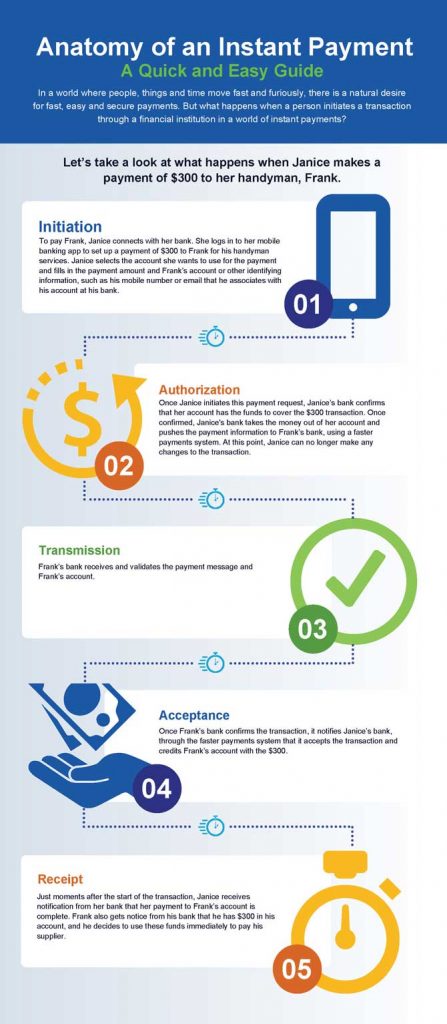If asked the meaning of “IP,” the expected results include intellectual property, internet protocol and for baseball fans, innings pitched. However, bankers quickly co-opted this acronym to mean “Instant Payments,” referencing the trend of immediate money movement. Most bankers are looking to this new capability to enhance consumer and business relationships and, simultaneously, compete with FinTech providers offering an expanded range of financial services.
We are in the early days of Instant Payments, but the market size of early U.S. adopters and the global migration to similar types of payment platforms indicate that this is more than a passing trend. Most community banks are not in this initial wave of adoption, so planning and coordination with trusted solution providers will be critically important. Also important will be the evaluation of potential use cases of the payments service and how those align with your target client segments.
For these reasons, organizations such as Wespay, the Faster Payments Council and the Federal Reserve diligently work to help community financial institutions understand these new payments networks and recognize the potential benefits to your clients.
The Definition
Wikipedia defines Instant Payments as “a method of exchanging money … allowing for almost immediate transfer of money between bank accounts, instead of the more typical one to three business days.” This definition is based on the European Central Bank’s (ECB) 2019 white paper.
In the U.S., the Federal Reserve acted as an industry catalyst, more than five years ago, in developing the Faster Payments Task Force, an industry consortium commissioned to help prepare U.S. organizations for faster payments. One of the deliverables of this group was an effectiveness criteria document that defined the vision of the future state of payments domestically. This document anticipates completing payment functions in seconds, with the entire end-to-end money movement occurring within minutes. Clearly, the evolution of payments in the U.S. mirrors the European vision.
The attached graphic prepared by FRB Services demonstrates the simplicity of an instant payment from initiation to receipt.
Evolution or Competitive Response?
All legacy U.S. payments systems have measured money movement in terms of days, except for the wire transfer networks. Checks, ACH, and even card transactions have required one day or more between payment initiation and the availability of good funds to the recipient. The ACH network has made in-roads in recent years through the expansion of Same Day ACH Services.
Meanwhile, non-bank solutions such as PayPal, Venmo (owned by PayPal), Square Cash and others have provided consumers and small businesses the capability to settle up or conduct commerce in real time. Members of Wespay have shared stories of declining balances and external transfers to these FinTech solutions that have eroded their customer relationships.
Unlike Zelle, which uses preexisting payment networks, Instant Payments are newly established payment rails operating only between regulated financial institutions. The initial U.S. service, Real-time Payments (RTP), was introduced by The Clearing House in late 2017 and is now adopted by most of the big banks in the country. RTP uses push payments, credit transactions that operate 24x7x365, and the payments are irrevocable. The network uses an international standard for messaging, which provides an essential prerequisite for possible international expansion.
In 2019, the Federal Reserve announced its intent to build a competitive solution to RTP, called FedNow. The FedNow service is slated for implementation in 2023 and will include many of the same characteristics of the RTP service. Both Federal Reserve and The Clearing House worked extensively to align the messaging standards and optimize the compatibility of the two services. Both organizations realize that most U.S. financial institutions will not have the capability or resources to build multiple new payment services. The interoperability of the two services is a crucial objective of many in the payments industry.
Business use cases for Instant Payments include just-in-time payables, consumer reimbursements and enhanced bill payment. The full benefit to businesses will require work to integrate these new process flows with in-house accounting and Enterprise Resource Planning (ERP) systems.
Consumer and Business Value
FinTechs’ innovation results in significant gains with consumers for person-to-person (P2P) payments, small value gifting, and settling-up of shared expenses. PayPal, Venmo and Square Cash were early solutions that are still widely used by consumers. The recent introduction of a bank-centric solution, Zelle, has been widely but not universally adopted by community institutions. Instant Payments, enabling immediate bank-to-bank transfers with the additional capability to confirm good funds receipt, are expected to be a viable and competitive solution for regulated financial institutions to deploy.
On May 24, 2021, Bloomberg reported that Square is planning a suite of payment services aimed at the small to mid-sized business segment to compete with larger banks. This client segment has historically been key to the success of community banks and will require continued innovation to remain competitive in business banking and treasury services. Instant payments may provide a critical new tool in the community banking service portfolio.
Business use cases for Instant Payments include just-in-time payables, consumer reimbursements and enhanced bill payment. The full benefit to businesses will require work to integrate these new process flows with in-house accounting and Enterprise Resource Planning (ERP) systems. Many businesses are considering the end goal to assist clients better and use service as a competitive differentiator.
What’s Next?
The Federal Reserve’s announcement of an Instant Payment solution has been an important motivational factor for many community banks. As the financial industry moves closer to the 2023 implementation of the FedNow service, we expect the volume of Instant Payments to turn up significantly. The Federal Reserve and The Clearing House are working with core systems providers and solution developers to integrate these capabilities into existing bank platforms.
Determining the right time to participate in Instant Payments is a decision I expect most financial institutions will make in the short-term. To do so, having adequate information to make a knowledgeable decision will be critical. And beginning the data gathering process as early as possible can aid community banks in evaluating their options and timing their solution availability to align with the needs of customers. Instant Payments are an ideal match with a bank’s overall digital strategy and can be merged for an impactful customer solution set.
William Schoch is President & CEO of Wespay, the nation’s oldest and one of the largest associations dedicated to helping members grow and improve their use of electronic payments. Appointed to this position in 2008, he is responsible for developing and implementing strategic initiatives to increase the association and provide maximum value to its 1000 members.
In 2016, Bill was the incorporator of Wespay Advisors, a wholly-owned subsidiary of Wespay, which provides payments consulting and risk management services. He serves as a Director and the Secretary of the Wespay Advisors Board.
Before joining Wespay, Bill spent 11 years at Visa International serving in various product leadership positions. As a business manager, he was responsible for the Original Credit Transaction (OCT), now marketed in the U.S. as Visa Direct. Bill also served as the global product manager for Visa’s debit products and founded the Visa International Global Debit Forum, which showcases new opportunities and best practices in debit program management. Visa seconded him to serve as the executive director of GlobalPlatform, a standards development consortium launched by Visa to proliferate multi-application smart card technology.
Prior to Visa, Bill spent eight years with Citibank in the treasury services division. He was responsible for developing, marketing and implementing various payments and collections solutions for Citibank’s corporate clients.
He started his professional career at Nacha where he provided staff support to the rules and operations committee and was actively involved in developing business-to-business payment applications in the ACH Network.
He received a Bachelor of Arts degree from the Indiana University
of Pennsylvania.
Bill currently serves on the Boards of Wespay, Wespay Advisors (Board Secretary), and Nacha. He also serves on the Operations Committee of the U.S. Faster Payments Council and is the Immediate Past Chair of the Center for Payments. Recently he served on the Board of USA Technologies, Inc. and the Federal Reserve’s Faster Payments Task Force. Bill is a member of the American Society of Association Executives (ASAE) and the California Society of Association Executives (CalSAE).











